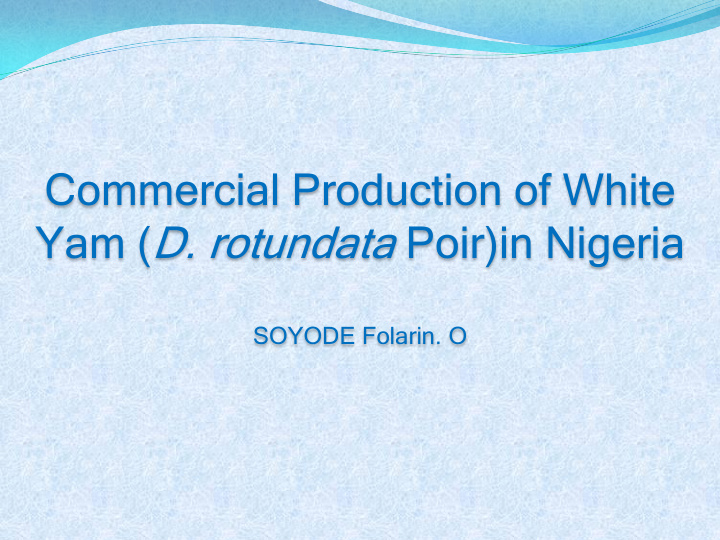



Commercial Production of White Yam ( D. rotundata Poir)in Nigeria SOYODE Folarin. O
OUTLINE • Introduction • White yam minisett production system in Nigeria • Post-harvest operations of white yam production • Constraints of white yam production
IN INTRODUCTION
• White yam ( D. rotundata ) is a storage organ and comes from the large genus Dioscorea and the second most important root/tuber crop in Africa. • White yam is a better food security food crop than many others. • White yam has special social-cultural importance and magnitude in the West Africa forest zone. • The occurrence of Dioscorea spp . in S. Asia, Africa and S. America pre-dates human history.
Botanical Description of Yam • Dioscorea is a large genus of over 600 species with subterranean tubers or rhizomes. • Many species produce bulbils in the axils of the leaves which have the morphology and appearance of condensed stems and in a few instances are relatively large and tuberous. • Yam progresses from propagules (true seeds or tubers),emerging seedlings or plantlets, mature plants, to senescing plants and dormant tubers.
White Yam Minisett Production in Nigeria Yam growth is enhanced at low altitudes with annual precipitation of about 1000-1400 mm and a mean annual temperature that ranges from 22 to 30 ° C. • Planting starts only at the beginning of the rainy season. • Planting season is usually between mid -March and the end of May. Important: Make sure the rains are well established and steady before planting.
Field Preparation • Deep, loose, and free -draining fertile soil with a pH close to neutral is required for the establishment of yam plants. • A field with little or no incidence of pests and diseases (viruses, insects, fungi, rodents and nematodes) is preferred. • Irrigation facilities are often required during the dry season-even in areas that are rain-fed.
The selected field should be as flat as possible, with no risk of erosion or tree stumps in the soil. • 100 kg/ha of urea is applied to the field before planting. • Whenever signs of soil nutrients deficiencies are observed when the yam are sprouting, another 50 kg/ha of urea is applied. • Fertilizer is best applied when the rainfall is steady. Fertilizer is applied in a circular or ring form around 10 cm of the yam seed planted.
CHEMICAL TREATMENT BEFORE PLANTING
• Minisetts are treated with the following mixture diluted in 10 L of water: Perfekthion (insecticide) 40 ml, Dithane M 45 (fungicide) 50 g, Basamid fumigant (nematcide) 10 g, and Wood ash 200 g. •Net bags containing mini -setts are soaked in the chemical for 2 to 3 minutes. • The treated minisetts are then allowed to dry in a cool and shaded place for 18 to 24 hours.
(a). Cut yam mini sets of (50gm-100gm). (b). Pack mini sets into net bags. (c). Prepare treatment solution. (d). Spread out to dry (e). Dip the yam into solution.
Planting Process The field is marked and clearly divided up into plots and sub-plots for each accession with tape, rope, and bamboo pegs of about 1 m length or any other appropriate material. • A spacing of 2.5 m per row is allocated for each block in the field with a pathway of 0.5 m between lines.
• Hoes are the preferred tools used for planting in small farms but heavy equipments can be made use of in mechanized farming. • A minisett is placed, face up.
Field Management Practices • Staking is carried out when yam vines start sprouting and crawling. The stakes are placed at a distance of about 50 cm from the plant. • Weeds are controlled by regular hand weeding (at least twice in a month for a period of 5 months) and the use of herbicides for effective weeds control. • Irrigation where available will help a lot.
Staking the growing yam vines
Manual weeding Weed control with chemical
Harvesting Procedures for yam At the point of senescence (drying of leaves and stems), yam tubers are ready for harvest. • The yam tubers are excavated from the soil with the aid of 2-m long iron rods, cutlasses, and hoes. • All relevant information for the process of harvesting, such as the number of tubers harvested per variety and the date harvested, is recorded and the inventory is updated with it.
CHEMICAL TREATMENT AFTER HARVESTING
The chemical treatment applied before planting is given to the newly harvested yam tubers. Management • After drying, yam tubers in net bags are transferred to the yam barns and placed on the shelves for 4 to 6 weeks. • Where possible, the harvested tubers should then be transferred to a store at temperature of 18 – 20 0 C.
Important: Compact storage should be avoided at this point to allow the flow of air around the tubers. . Storing harvested yam tubers in a yam barn
Managing Pest and Diseases in the Field and During Storage • It is necessary to treat yam tubers before and after planting. • Frequent treating with insecticide in the field. • Yam tubers that are already affected by diseases in the field should never be stored for replanting. • Optimum storage conditions are required
CONSTRAINTS OF YAM PRODUCTION
• Healthy and enough planting materials • High cost of farm equipments. • Storage facilities. • Market forces • Technical know-how
Conclusion • A planting space of 1m by 1m between rows and 0.5m between individual plants should give up to 1000 stands per hectare. • Expected yield per hectare is 15-20 tonnes. • There is vast amount of opportunities for investors in commercial yam production. • There is a good sense of pride and belonging
Recommend
More recommend